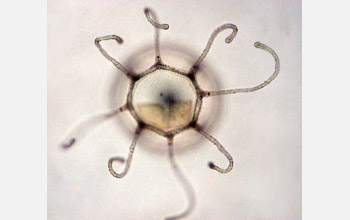Multimedia Gallery
Jellyfish Turritopsis dohrnii
Hydrozoan species Turritopsis dohrnii medusa, or jellyfish, collected in Florida.
Jellyfish invasions--mediated by humans--have been reported all around the world, and the ballast water from ships has been recognized as a main source of these marine invasions. Ships take on ballast water, needed for stability, in originating harbors. In destination harbors, ships may dump their ballast water along with accompanying organisms, including jellyfish. Jellyfish that are released into non-native habitats may colonize them--particularly if they face few or no predators in these areas. Some invasions have dramatic economic and ecological consequences while others, especially in the marine realm, can go unnoticed.
Maria Pia Miglietta, a research professor from the University of Notre Dame, has identified a human mediated, worldwide introduction to the hydrozoan species Turritopsis dohrnii. The normal life cycle of hydrozoans involves the asexual budding of the medusa, or jellyfish, form from colonial polyps. But the medusae of T. dohrnii, when starved or damaged, are able to revert their life cycle back to the polyp stage through a process called transdifferentiation, allowing them to easily survive long journeys in cargo ships and ballast waters. This potential immortality of T. dohrnii could have devastating consequences for the fishing and tourist industries.
To learn more about the increase in jellyfish populations worldwide and the problems they are causing, see the NSF Special Report "Jellyfish Gone Wild!" (Date of Image: 2007)
Credit: Maria Pia Miglietta
Images and other media in the National Science Foundation Multimedia Gallery are available for use in print and electronic material by NSF employees, members of the media, university staff, teachers and the general public. All media in the gallery are intended for personal, educational and nonprofit/non-commercial use only.
Images credited to the National Science Foundation, a federal agency, are in the public domain. The images were created by employees of the United States Government as part of their official duties or prepared by contractors as "works for hire" for NSF. You may freely use NSF-credited images and, at your discretion, credit NSF with a "Courtesy: National Science Foundation" notation.
Additional information about general usage can be found in Conditions.
Also Available:
Download the high-resolution JPG version of the image. (2.2 MB)
Use your mouse to right-click (Mac users may need to Ctrl-click) the link above and choose the option that will save the file or target to your computer.

